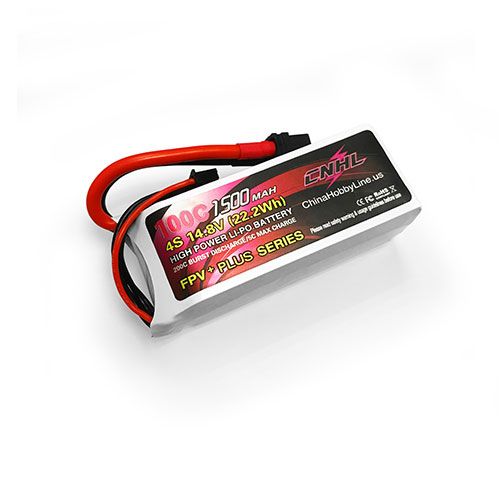
Let's talk about batteries for FPV
Share
Let’s talk about batteries in this hobby.
When I started in the FPV hobby I had no idea that the batteries itself was a completely new world. When you hear about batteries you think about AA, AAA, 9V and the Duracell bunny. But nothing of that applies in this world.
For starts the battery composition is different. LiPo, short for Lithium Polymer, is the main name heard when talking about FPV together with batteries. You hear Li-ion also sometimes, but more for goggles and radios (and I’ve heard about some long-range drones using them), than for the drones itself.
The main reason seems to be in the importance of weight. LiPo batteries are lighter than other batteries storing the same amount of energy, and you can easily understand that weight is important when flying a drone.
My first contact with LiPo was using my Tinyhawk, which has a very simple USB charger. This charger doesn’t allow you to configure anything, and it just have a red/green light showing the battery state, so up to that point everything seemed easy and familiar.
But just after a couple of weeks flying, I realised one of my batteries has swelled, and doing a little research I came to the beginning of this trip in the battery world.
Seems like this kind of batteries are very sensitive to under and over charging, to the point of becoming a bit dangerous and potentially fire hazards. Therefore, there’s a big aftermarket of things like LiPo bags and even using ammunition cases to store these batteries.
The swelling came probably because I over discharged the battery while flying. LiPo batteries shouldn’t go under 3.0 V. Of course, the numbers you see in your OSD when flying are not an exact science, and even if you stop flying your drone at 3.0V, land, wait a few seconds, and you measure your battery, you will see a very different number, probably in the order of 3.2 V.
LiPo batteries are also very easy to suffer from a puncture. Again, since the weight is important there’s no metal or case protecting the cells, and everyone agrees that if while flying you manage to puncture a battery, is much safer to discard it in a proper way that to keep using it.
These batteries will normally have a detail label on it, with the number of cells, the discharge rate, and the capacity of the battery.
I won’t enter into so much detail since it will make this blog entry almost infinite, but what I can say as a summary of those numbers is that the cell count (1S, 2S, 4S, etc) is important for the kind of motor you have in your drone, there’s a direct relationship between them, the capacity (1300mAh, 850mAh) can be translated as how long will the battery last (but it’s also very integral to the weight), and the last, the discharge rate (70C, 100C) is supposed to be related to the punch the battery can take in certain movements of the drone. In my little experience I have not felt the difference between any of my batteries when it comes to the discharge rate, but I honestly have used only good brands batteries with higher than 70C all the time).
When it comes to charging them, I have just two things to say. The first is to make sure to always connect the balance cable. 1S batteries don’t have a balance cable since there’s nothing to balance, it’s just one cell. But as soon as you enter 2S, you need to make sure the cells are balanced, otherwise you can over charge one of them in the charging process and there comes the fire hazard.
The second is: Do not use parallel charging. There are a huge number of parallel boards, even famous people like Joshua Bardwell has design and sell a parallel board. And there are so many pages teaching you how to charge using them, but in my personal opinion is just tempting fate, and I don’t think there’s a real excuse to “play with fire” that way.
My few last thoughts about batteries are to invest in a charger that will satisfy your needs, something that is safe and will last you. In my personal opinion an AC dual charger is the best investment. You can use it at home, charge two batteries at the same time, it won’t break the bank and it’s an investment you do once.
LiPo batteries has a much shorter life spam than other batteries. For one they are at risk of puncture since you are flying them around and you crash your drone time to time. Then you also have the very limited number of cycles these batteries can charge, something around 150-250 cycles, compared to 1000 cycles in a NiMh battery for example, and lastly, they degrade over time. I believe that after 2 years their capacity is reduced quite a lot. So, don’t cheap out with batteries. If in doubt just change it and discard properly your old battery.
Last comment is around charging rate. The safe way is to charge it at 1C. This means that if your battery is 1500mAh, you charge it at 1.5 amp. Nowadays there are battery manufacturer trying to get more people to buy their batteries claiming they can charge at higher rates, and despite the fact that there hasn’t been a major problem because of this that I’m aware of, it’s in my opinion, not the reason why you should chose a battery. I rather go on the safe side, charge it at 1C and have higher chances of not burning down something.
This entry turned longer than I thought but if you want to learn more there’s a lot on the internet, one source I like is: https://rogershobbycenter.com/lipoguide, and don’t forget we have very good batteries at an excellent price at NordFPV.
